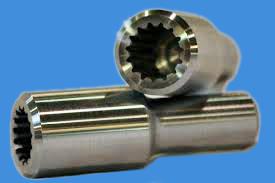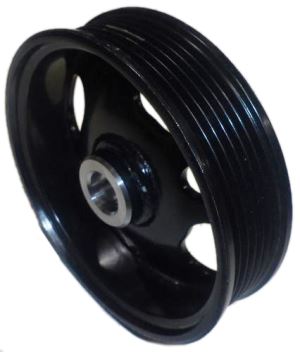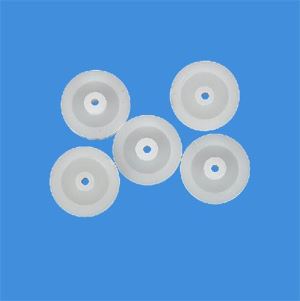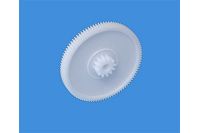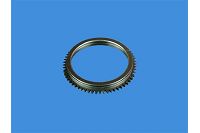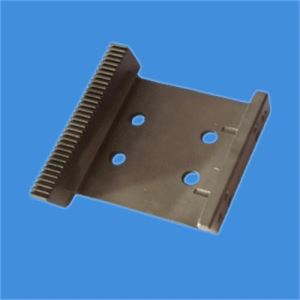Product Categories
Ground and rolled ball screws function nearly identically within a broad range of mechnical applications. However, the raceway surfaces, which are very similar to traditional machine screw threads found in a typical screw/nut system, are differentiated by the manufacturing process used to create these features. Beside from the hardened ball bearings that make rotational motion possible, a ball screw system consists of two basic components: lead screw which possesses external threads and the ball nut which possesses internal threads. A grasp of the two distinct manufacturing processes used to fabricate these components is the key to understanding both the strengths and limitations of rolled and ground ball screws.
Rolled ball screw threads are created by pushing each uncut bar stock blank through rotating tool dies in a single operation. The driving principle behind this process is a cold work deformation process where the blank material is literally shaped by rolling tooling dies which are designed to form both the internal and external threads of the lead screw and ball nut. Although the rolling dies come in a wide variety of shapes and sizes as required to roll various thread sizes, the deformation principle is the same for both internal and external threads. The rolling process is highly efficient because no material is physically removed from the cut blanks, as would be the case in any cutting or grinding process. The process is widely used throughout the industry because it can be easily automated to achieve high rates of production.
Strengths and Limitations
Rolled screw threads generally possess more strength than ground screw threads due to the significant material strengthening that is achieved as a result of the large plastic deformation induced in the material to create the threads during the rolling process. Rolled threads are the more cost effective option because they can be quickly fabricated in automated rolling machine setups. Because the rolling process is a considered to be a “one shot” process, any fabrication errors in the rolled screw threads are nearly impossible to fix. Rolled threads also tend to possess rougher surface finishes than ground threads, and this can be especially problematic because rough surface threads can lead to reduced mechanical efficiency due to the higher rolling friction encountered in the rolling ball bearings. A rough surface finish can also contribute to an overall decrease in the wear resistance of the ball screw system.
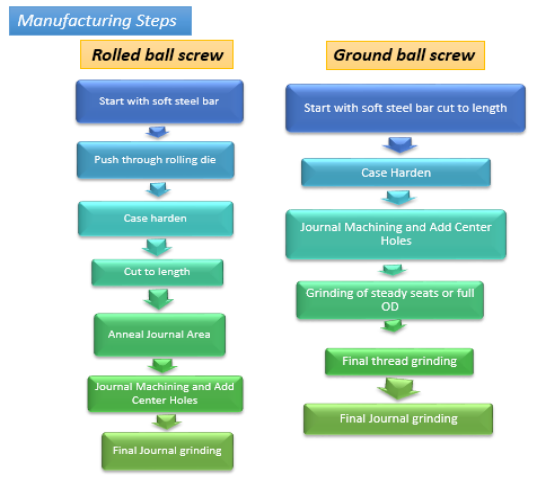
Finally, rolled ball screw systems are especially vulnerable to dimensional distortions as a result of die tooling wear. These sources of error can lead to a ball/nut system that possesses excessive backlash, which occurs due to a mismatch between the bearing diameter and screw shaft threads, and it also sharply decreases the positional accuracy that can be achieved.
Conversely, the thread grinding process is inherently more time intensive than the rolling process, partly because of the specialized grinding tools required for the cutting operation. This translates into a significantly higher “off the shelf” price tag for ground ball screws compared to rolled ball screws. However, there is a significant benefit achieved for the higher cost process because the ground threads can be held to tighter tolerances in relation to the centerline of the material blank because each thread is ground one at a time. For these reasons, ground ball screws are almost exclusively employed in applications where high degrees of precision and repeatability are required.
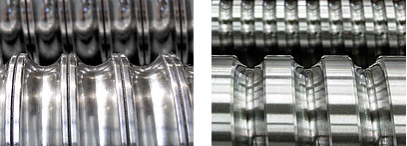
Rolled ball screws Ground ball screws
Rolled ball screw systems will generally cost significantly less than ground ball screws, and should be more than serviceable for use in most applications. Both rolled and ground balls screws are available in a wide variety of lengths, diameters, and load capacities to fit a broad range of applications. However, if very high degrees positional accuracy is required, to a high degree of repeatability, it may be more than worth the cost to opt for a precision ground ball screw system. The engineer must carefully consider these distinctions when tasked with selecting between the two for any given machine application.
Related Industry Knowledge
- Comparison of cold rolled and lappe...
- TBI ball screw is also known as bal...
- About rack processing
- Four heat treatment processes of pl...
- Precision gearcar burizing and quen...
- Calculation of planetary gear ratio
- The Time Line of Gears
- Ball Screws Used for Latest Innovat...
- Recirculation System and Attributes...
- Characteristics of spline
- Design and processing technology of...
- Noise on gear box
- Characteristics of gear box
- Simple overview of the gear box
- experience on pulleys
- Pulley Assembly considerations
- Pulley installation and removal
- Pulley standard


